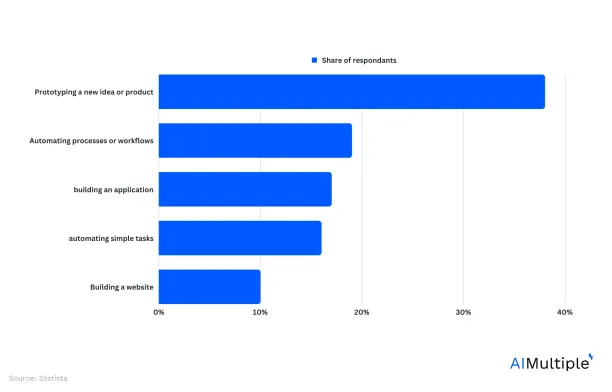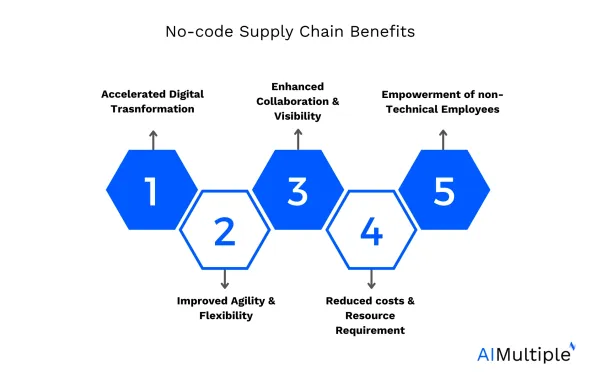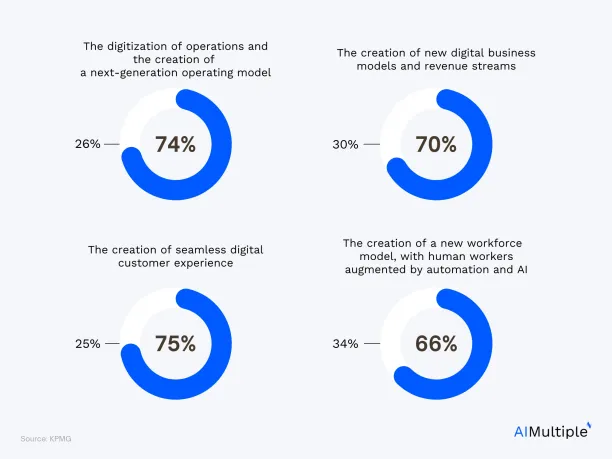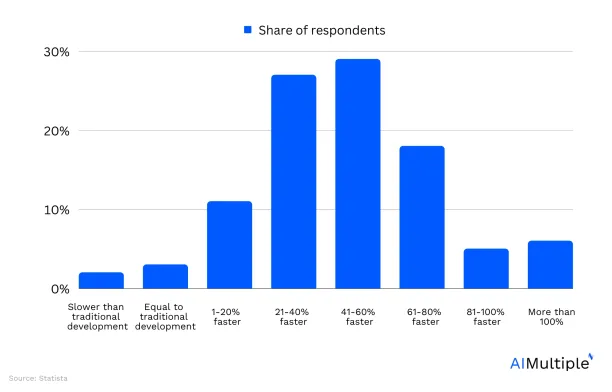No Code Supply Chain in 2024: Benefits & Vendor Benchmark


No-code technology has emerged to be an effective way of deploying interoperable and customized digital solutions in your organization. Though it is hard to quantify the impact of no code, it is significant. Gartner expects 70% of new applications to utilize low or no-code technology by 2025.
In supply chain management (SCM), where flexibility and process excellence can be strategic differentiators, no-code tools can be a game-changer. To help supply chain leaders successfully implement no-code solutions in their organizations, this article:
- Explores how no-code supply chain management can optimize your business operations,
- Provides insights into the top benefits of adopting a no-code platform
- Offers guidance on selecting the ideal solution for your organization
What is No-Code?
No-code is a technology that allows users to create and manage applications without the need for learning programming languages (i.e., coding) skills. No-code platforms empower teams to utilize:
- Visual interfaces
- Drag-and-drop features
- Pre-built templates
to develop custom solutions that can streamline and automate various aspects of the business.
No code solutions were initially (in 2010s) used in simpler, departmental applications, but they are now increasingly being used in enterprise-scale, multi-stakeholder processes.
Here are some of the problems businesses are solving through no-code solutions:
Figure 1. Top problems businesses are solving through no-code solutions globally1

What are the alternatives to no code?
Before diving into the alternatives of no-code, it is important to understand the dimensions of no-code alternatives.
Dimensions of no-code alternatives
There are 2 important dimensions in analyzing alternatives to no-code solutions:
1. Domain specificity
Domain-specific solutions can allow users to achieve a faster ramp-up within a specific domain by encapsulating generally accepted processes and data models. The downside is that no company completely follows generally accepted processes. To leverage the supply chain as a competitive advantage, companies use their own processes and data models, which require them to significantly customize domain-specific solutions.
2. Code-level
Low and no-code-based solutions are alternatives to no-code that can offer greater flexibility at the cost of longer development cycles.
No-code alternatives
There are 3 alternatives to no-code:
1. Domain-specific no code + code-based solutions
Solutions like Supply Chain Management (SCM) systems are domain-specific configurable solutions from vendors like Oracle and SAP.
- They offer numerous customization options.
- Customizations have limitations, and consultants need to switch to coding for complex integrations and workflows.
2. Low-code solutions
Solutions like Mendix can be applied to any business domain to rapidly build solutions. They offer a combination of no-code capabilities like drag & drop GUIs as well as code-based interfaces.
- They increase development and iteration speed.
- They are designed to be used by developers, which limits their user base and adoption.
3. Code-based solutions
Leveraging professional programming teams, companies can build custom solutions for their business.
- Offers complete customization
- Requires significant effort to build and even more effort to maintain such custom solutions. Companies rarely build code-based solutions for their supply chain from scratch in the 2020s.
Comparison of the no-code alternatives
Compared to higher code-based alternatives, no-code offers:
- Faster development cycles
- Broader adoption: Domain experts can build functionality with minimal reliance on IT
- Risk of shadow IT if the development journey is not well managed. Though no-code tools can be built by non-technical professionals, software development best practices need to be followed.
Compared to domain-specific solutions, no code offers:
- Increased customization options
- Faster development cycles
- Risk of redundant development work if your company almost always follows generally accepted supply chain processes and data structures. Such processes are built into domain-specific solutions and can be leveraged off the shelf. Customizable options make sense for supply chain leaders that want to turn their supply chain to one of their company’s competitive advantages.
What does no-code mean for the supply chain industry?
The adoption of no-code technology in supply chain management has opened the door to a host of optimization opportunities. These opportunities include enhanced visibility, increased efficiency, and improved collaboration among stakeholders and other business partners across the vertical supply chain.
Top 5 benefits of no-code platforms for supply chain optimization

1. Accelerated digital transformation
Due to the pandemic-induced digital acceleration (Figure 1), businesses must adapt quickly to remain competitive. No-code platforms enable organizations to fast-track their digital transformation by empowering employees to create and deploy applications that address specific supply chain challenges without relying on IT or developer resources.
For instance, a retail company can use a no-code platform to develop an inventory management application that provides real-time updates on stock levels. That data can help the retailer in making more informed purchasing decisions and reducing stockouts.
Figure 1. Impact of the Pandemic on digital transformation2

2. Improved agility and flexibility
In today’s dynamic market environment, businesses must be able to adapt to changing customer demands and market conditions. No-code platforms offer the flexibility to rapidly create and modify applications as needed, allowing supply chain managers to respond quickly to evolving requirements.(Figure 3)
A manufacturing company, for instance, can use a no-code platform to develop a production scheduling application. Custom parameters can be added to the application helping the company adapt to fluctuations in demand, resulting in optimal resource allocation and reduced lead times.
Figure 3. Low or no-code development is much faster than traditional3

3. Enhanced collaboration and visibility
Supply chains are now complex networks with multiple suppliers and partners working together. No-code solutions facilitate collaboration across teams by providing a centralized platform where all stakeholders can access and contribute to the development and management of supply chain applications. This increased visibility allows for better decision-making and ensures that all parties are aligned on objectives and expectations.
Suppose a logistics service provider (LSP) leverages a no-code platform to develop a tailored shipment tracking application. Such an application built on the no-code supply chain platform used by the LSP will be easier to integrate with the existing systems compared to a new SaaS solution. The application can then offer real-time visibility into shipment status for both the LSP and its customers, leading to improved communication and customer satisfaction.
4. Reduced costs and resource requirements
Traditional software development can be time-consuming and expensive, often requiring significant investment in IT infrastructure and developer resources. No-code platforms eliminate these barriers, allowing businesses to develop and deploy supply chain applications at a fraction of the cost, with minimal resource requirements.
A small business, for instance, can use a no-code platform to develop a demand forecasting application that helps optimize inventory levels and minimize carrying costs without the need for a dedicated IT team or new costly software licenses.
5. Empowerment of non-technical team members
A supply chain analyst with limited coding experience may need to access data from internal applications. A no-code platform can help them create a custom dashboard that tracks key performance indicators without the need for coding skills. This can allow the analyst to identify areas for improvement and make data-driven decisions without relying on IT support.
No-code platforms democratize the application development process by eliminating the need for coding expertise, enabling non-technical team members to actively contribute to supply chain optimization efforts.
Top 5 factors to consider when selecting a no-code platform for your supply chain
Choosing the right platform or vendor can be overwhelming due to the wide range of considerations that need to be taken into account and questions that need to be answered. This section provides some points to keep in mind while looking for no-code supply chain optimization platforms.
1. Scalability
As your business grows, so will your supply chain needs. It’s crucial to select a platform that can scale with your organization, supporting increasing data volumes, user counts, and application complexity.
Key Considerations:
- Consider the platform’s ability to handle a growing number of users and applications
- See if the platform offers flexible pricing options that cater to your organization’s growth.
- Check if there are any limitations on data storage, processing capabilities, or integrations. For instance, NoSQL data storage capabilities can make it easy for your team to work with unstructured data.
2. Ease of use and adoption
To maximize the benefits of a no-code platform, your team must be able to use it effectively. Choose a platform with an intuitive interface and a shallow learning curve to ensure widespread adoption across your organization.
Key Considerations:
- Is the platform’s interface user-friendly and easy to navigate?
- Check if the vendor offers training materials and support for your team to help them get started
- Can the platform be easily integrated into your existing workflows and processes?
- See if the platform offers demos so that your team can get a hands-on experience.
3. Customization and flexibility
Every supply chain is unique, and your no-code platform should be able to cater to your specific requirements. Look for a platform that offers a high degree of customization, allowing you to create applications tailored to your organization’s needs.
Key Considerations:
- Does the platform provide a wide range of pre-built templates and components?
- Can you easily modify these templates and components to suit your specific use cases?
- Are there any limitations on the customization of the platform’s interface, reporting, or analytics capabilities?
4. Integrations to existing systems
To ensure seamless data flow and interoperability, the platform should be able to integrate with your existing supply chain systems, such as:
- Enterprise resource planning (ERP) systems
- Warehouse management systems (WMS)
- Transportation management systems (TMS)
Key Considerations:
- Does the platform offer pre-built integrations with popular supply chain systems?
- Can you easily build custom integrations using APIs or other integration tools?
- Is the platform capable of supporting real-time data synchronization between systems?
- Does the platform offer composable capabilities?
5. Security and compliance
Protecting your sensitive supply chain data is crucial. Select a no-code platform with robust security measures and compliance certifications in place to safeguard your information and maintain regulatory compliance.
Key Considerations:
- Are there regular security audits, vulnerability testing, and updates to ensure ongoing protection?
- Does the platform offer features such as role-based access control, data encryption, and secure user authentication?
No-code and low-code supply chain platform providers
There are tens of no-code and low-code vendors. AIMultiple relied on public and verifiable data to identify the top providers. Low-code is a more mature technology for enterprise applications; therefore, low-code vendors tend to be larger than upcoming no-code vendors. Therefore, we used different list inclusion criteria for each type of vendor.
The inclusion criteria are:
- The number of employees is correlated with a company’s revenues which is a good measure of the success of its product.
- No-code vendors: 25+ employees on Linkedin
- Low-code vendors: 1,000+ employees on Linkedin
- Claims to offer a no-code or low-code solution
- Includes building blocks for supply chain management
Table 1. Vendor comparison
| Vendors | Type of solution* | Integrations to SCM platforms*, ** | # of employees on LinkedIn as of April 2023 |
|---|---|---|---|
| Pegasystems | Low code | – SAP – Oracle – Microsoft SQL server – PostgreSQL | 5,803 |
| Appian | Low code | – SAP – Oracle | 2,271 |
| OutSystems | Low code | – SAP – MongoDB – PostgreSQL | 1,960 |
| Mendix | Low code | – SAP – Siemens Teamcenter | 1,284 |
| UCBOS | No code | – SAP – Oracle SCM – Mercury Gate TMS –
Manhattan – Blueyonder – Coupa
| 53 |
| Regrello | No code | – Oracle – SAP | 38 |
You can also check our data-driven list of no-code supply chain software to find the best option that suits your business needs.
Notes (Table 1):
- Based on vendor claims: *
- Not comprehensive: **
- The vendors compared in this table were selected based on the relevance of their offerings and having 25+ employees.
Further reading
- Top 12 AI Use Cases for Supply Chain Optimization
- Top 5 Steps To Improve Supply Chain Visibility
- Achieving Resilience Through Business Composability
If you need help finding a vendor or have any questions, feel free to contact us:
External resources
- 1. Formstack. (2021). What problems were you trying to solve with no-code tools?. Statista. Statista Inc. Accessed: August 07, 2023.
- 2. KPMG. Digital Acceleration. Accessed: 08/August/2023
- 3. Creatio. (2021). How much faster is low-code development comparing to traditional development?. Statista. Statista Inc.. Accessed: 08/August/2023.



Comments
Your email address will not be published. All fields are required.